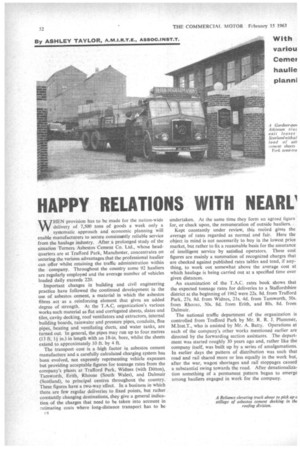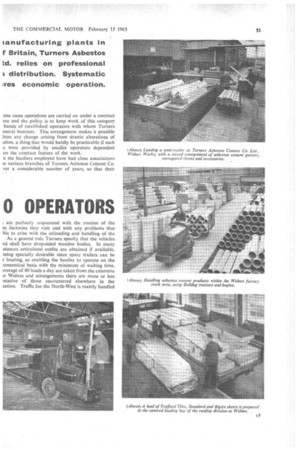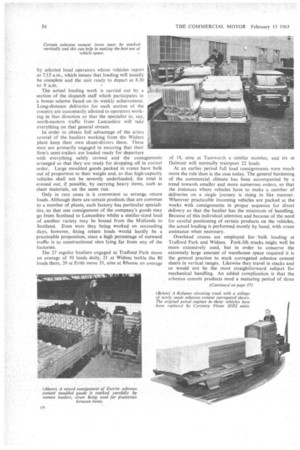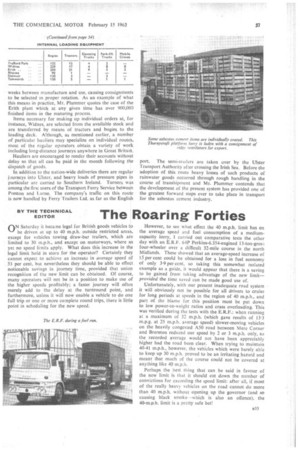HAPPY RELATIONS WITH NEARI: 0 OPERATORS
Page 54

Page 55

Page 56

Page 59

If you've noticed an error in this article please click here to report it so we can fix it.
WHEN provision has to be made for the nation-wide delivery of 7,500 tons of goods a week only a systematic approach and economic planning will enable manufacturers to secure consistently reliable service from the haulage industry. After, a prolonged study of the situation Turners Asbestos Cement Co. Ltd., whose headquarters are at Trafford Park, Manchester, concentrates on securing the various advantages that the professional haulier can offer whilst retaining the traffic administration within the company. Throughout the country some 92 hauliers are regularly employed and the average number of vehicles loaded daily exceeds 220.
Important changes in building and civil engineering practice have followed the continued development in the use of asbestos cement, a material in which the asbestos fibres act as a reinforcing element that gives an added degree of strength. At the T.A.C. organization's various works such material as flat and corrugated sheets, slates and tiles, cavity decking, roof ventilators and extractors, internal building boards, rainwater and pressure pipes, conduits, flue pipes, heating and ventilating ducts, and water tanks, are turned out. In general, the pipes may run up to four metres (13 ft. if in.) in length with an 18-in, bore, whilst the sheets extend to approximately 10 ft. by 4 ft.
The transport cost is a high factor in asbestos cement manufacture and a carefully calculated charging system has been evolved, not expressly representing vehicle expenses but providing acceptable figures for tonnage rates from the company's plants at Trafford Park, Widnes (with Ditton), Tamworth, Erith, Rhoose (South Wales), and Dalmuir (Scotland), to principal centres throughout the country. These figures have a two-way effect. In a business in which there are few regular deliveries to fixed points, but rather constantly changing destinations, they give a general indication of the charges that need to be taken into account in estimating costs where long-distance transport has to be undertaken. At the same time they form an agreed figure for, or check upon, the remuneration of outside hauliers.
Kept constantly under review, this record gives the average of rates regarded as normal and fair. Here the object in mind is not necessarily to buy in the lowest price market, but rather to fix a reasonable basis for the assurance of intelligent service by satisfied operators. These cost figures are mainly a summation of recognized charges that are checked against published rates tables and tend, if anything, to work out somewhat above the average cost at which haulage is being carried out at a specified time over given distances.
An examination of the T.A.C. rates book shows that the expected tonnage rates for deliveries to a Staffordshire district at the beginning of 1962 were 22s. 8d. from Trafford Park, 27s. 8d. from Widnes, 21s. 4d. from Tamworth, 50s. from Rhoose, 50s. 8d. from Erith, and 80s. 8d. from Dalmuir.
The national traffic department of the organization is controlled from Trafford Park by Mr. R. R. J. Plummer, M.Inst.T., who is assisted by Mr. A. Batty. Operations at each of the company's other works mentioned earlier are directed by the forwarding section assistants. The department was started roughly 30 years ago and, rather like the company itself, was built up by a series of amalgamations. In earlier days the pattern of distribution was such that road and rail shared more or less equally in the work but, after the war, wagon shortages and rail stoppages caused a substantial swing towards the road. After denationalization something of a permanent paitern began to emerge among hauliers engaged in work for the company. ; are perfectly acquainted with the routine of the at factories they visit and with any problems that ble to arise with the unloading and handling of the As a general rule Turners specify that the vehicles ed shall have drop-sided wooden bodies. In many stances articulated outfits are obtained if available, leing specially desirable since spare trailers can be r loading, so enabling the haulier to operate on the 'conomical basis with the minimum of waiting time. iverage of 80 loads a day are taken from the extensive it Widnes and arrangements there are more or less :ntative of those encountered elsewhere in the zation. Traffic for the North-West is mainly handled by selected local operators whose vehicles report at 7.15 a.m., which means that loading will Usually be complete and the unit ready to depart at 8.30 to 9 a.m. •
The actual loading work is carried out by a section of the dispatch staff which participates in a bonus scheme based on its weekly achievement. Long-distance deliveries for each section of the country are customarily allotted to operators working in that direction so that the specialist in, say, north-eastern traffic from Lancashire will take everything on that general stream.
In order to obtain full advantage of the artics several of the hauliers Working from the Widne.s plant keep their own shunt-drivers there. These men are primarily engaged in ensuring that their firm's semi-trailers are loaded ready for departure with everything safely stowed and the consignments arranged so that they are ready for dropping off in correct order. Large moulded goods packed in crates have bulk out of proportion to their weight and, so that high-capacity vehicles shall not be severely underioaded, the total is evened out, if possible, by carrying heavy items, such as sheet materials, on the same run.
Only. in rare cases is it convenient to arrange return loads. Although there are certain products that are common to a number of plants, each factory has particular specialities, so that one consignment of the company's goods may go from Scotland to Lancashire whilst a similar-sized load of another variety may be bound from the Midlands to Scotland. Even were they being worked on succeeding days, however, fixing return loads would hardly be a practicable proposition, since a high percentage of outward traffic is to constructional sites lying far from any of the factories.
The 27 regular hauliers engaged at Trafford Park move an average of 50 loads daily, 21 at Widnes tackle the 80 loads there, 20 at Erith move 35, nine at Rhoose an average of 18, nine at Tamworth a similar number, and six at Dalmuir will normally transport 22 loads.
At an earlier period full load consignments were much more the rule than is the case today. The general hardening of the commercial climate has been accompanied by a trend towards smaller and more numerous orders, so that the instances where vehicles have to make a number of deliveries on a single journey is rising in like manner. Wherever practicable incoming vehicles are packed at the works with consignments in proper sequence for direct delivery so that the haulier has the minimum of handling. Because of this individual attention and because of the need for careful positioning of certain products on the vehicles, the actual loading is performed mostly by hand, with crane assistance when necessary.
Overhead cranes are employed for bulk loading at Trafford Park and Widnes. Fork-lift trucks might well be more extensively used, but in order to conserve the extremely large amount of warehouse space required it is the general practice to stack corrugated asbestos cement sheets in vertical ranges. Likewise they travel in stacks and so would not be the most straightforward subject for mechanical handling. An added complication is that the asbestos cement products need a maturing period of three
weeks between manufacture and use, causing consignments to be selected in proper rotation. As an example of what this means in practice, Mr. Plummer quotes the case of the Erith plant which at any given time has over 900,000 finished items in the maturing process.
Items necessary for making up individual orders at, for instance, Widnes, are selected from the available stock and are transferred by means of tractors and bogies to the loading deck. Although, as mentioned earlier, a number of particular hauliers may specialize on individual routes, most of the regular operators obtain a variety of work including long-distance journeys anywhere in Great Britain.
Hauliers are encouraged to render their accounts without delay so that all can be paid in the month following the dispatch of goods.
In addition to the nation-wide deliveries there are regular journeys into Ulster, and heavy loads of pressure pipes in particular are carried to Southern Ireland_ Turners was among the first users of the Transport Ferry Service between Preston and Larne. The company's traffic on this route is now handled by Ferry Trailers Ltd. as far as the English port. The semi-trailers are taken over by the Ulster Transport Authority after crossing the Irish Sea. Before the adoption of this route heavy losses of such products of rainwater goods occurred through rough handling in the course of transhipment and Mr. Plummer contends that the development of the present system has provided one of the greatest forward steps ever to take place in transport for the asbestos cement industry.












































































































